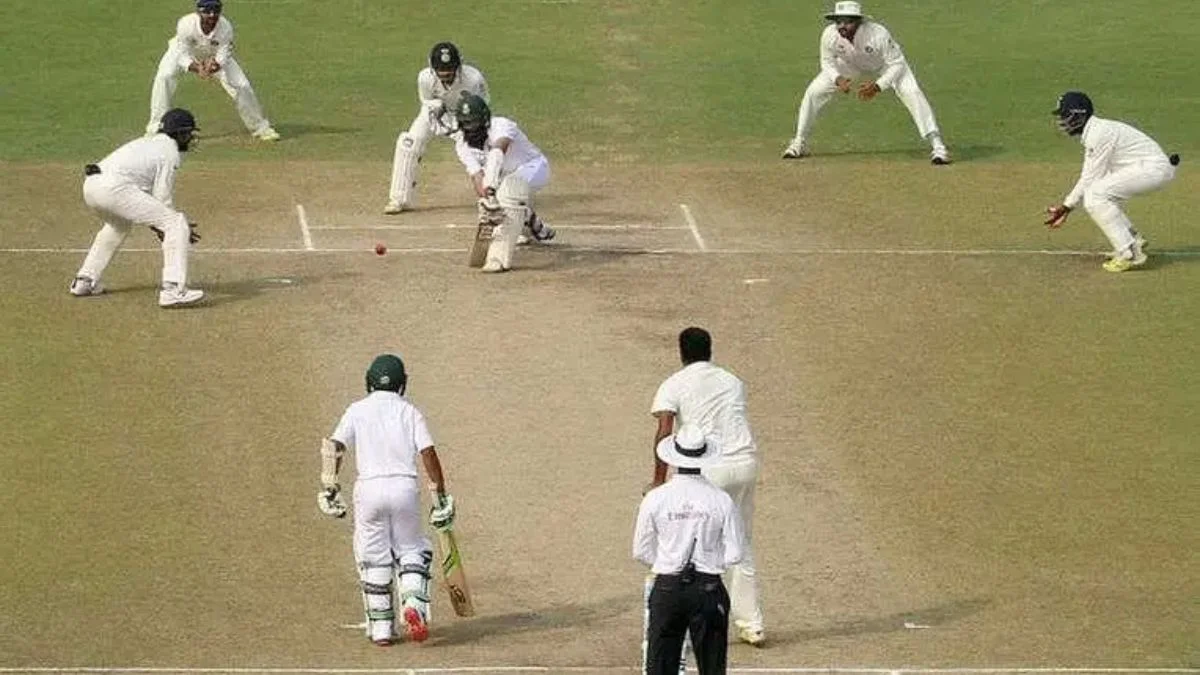Aggressive Fielding setups in Test cricket are meant to put pressure, induce mistakes, and extract a wicket-taking opportunity. Although the particular positions may differ based on the bowler, pitch, and batsman, there are four aggressive configurations commonly seen in international cricket.
4 Aggressive fielding setups for Test Cricket
The Slip Cordon Trap (New Ball, Fast Bowlers)

Setup: Arguably the most traditional attacking Test match field. It usually has 3-4 (and even 5-6 in extreme situations) slips, a gully, and a wicketkeeper. Occasionally, a wide first slip or a backward point may also be included.
Purpose: The objective is to catch edges off the bat from the speed and movement created by fast bowlers using the new ball. Fielders are stationed near the batsman to take maximum catches as the ball travels rapidly off the bat.
When to Use: Early in an innings off a new ball, on deliveries that have seam movement or swing, and against batsmen who play away from their body or are easy to get out on the outside edge. England’s Ben Stokes and Brendon McCullum side has used a very attacking slip cordon in the past.
Close-In Catching for Spinners (Turning Pitches)

Setup: In the presence of considerable turn and bounce in the pitch, captains tend to post fielders quite close to the bat. This generally involves a silly point (on the off-side, extremely close to the batsman’s bat), a short leg (on the leg-side, close to the batsman’s hip/pads), and occasionally a leg slip or silly mid-on/mid-off.
Purpose: These positions are for catching balls that pop up off the bat or pad because of a sharp turn, bounce, or mis-timing. The closeness of the fielders puts tremendous pressure on the batsman, and it is hard to rotate the strike or play freely.
When Used: Works best on parched, dusty pitches on day 4 or 5 of a Test, when the spinners are getting the most out of turn and bounce. India, on turning pitches, or subcontinent-playing teams, often use these configurations.
The Short Ball Trap (Leg-Side Focus)

Setup: This attack setup is employed when a fast bowler is attacking the batsman with short-pitched balls. It can also include a fine leg, deep square leg, long leg (or deep backward square leg), and either a short leg or leg gully. Fielders on the off-side can be edged a bit wider or deeper to compensate for powerful pulls/hooks.
Purpose: To lure the batsman to play the hook or pull shot, and the fielders to be placed strategically to catch miskicked attempts. The short leg is for balls that pop off the splice or gloves.
When employed: Against pull/hook strong batsmen, or those who are likely to be kept out by persistent short-pitched bowling. Also, to get a new batsman into trouble, or when seeking a breakthrough in the face of a long stand. Australian sides, with their glorious tradition of fast bowling, tend to employ variations of this snare.
“Ring of Steel” with Aggressive Infield (To Stop Scoring & Put Pressure)

Setup: Although not necessarily about direct catching, this setup can be extremely hostile in its attempts to dry up runs and humble the batsman. It is usually associated with having nearly all infielders in close catching/stopping positions (such as point, cover, mid-off, mid-on, square leg, mid-wicket), with only two or three players holding back for boundaries.
Purpose: Preventing easy singles and boundaries, compelling the batsman to go on the gamble to score. This constant pressure can result in errors and eventually wickets, even if not held directly in the immediate ring.
When Used: Typically used when a team is attempting to create sustained pressure, maybe with a more seasoned ball, or when the pitch is not providing excessive movement. It’s a containment to attack, tire the batsman out. This is a favorite trick by any team wanting to stem the flow of runs and hoping for opportunities.





























